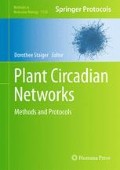Abstract
Circadian biology is a major area of research in many species. One of the key objectives of data analysis in this field is to quantify the rhythmic properties of the experimental data. Standalone software such as our earlier Biological Rhythm Analysis Software Suite (BRASS) is widely used. Different parts of the community have settled on different software packages, sometimes for historical reasons. Recent advances in experimental techniques and available computing power have led to an almost exponential growth in the size of the experimental data sets being generated. This, together with the trend towards multinational, multidisciplinary projects and public data dissemination, has led to a requirement to be able to store and share these large data sets. BioDare (Biological Data repository) is an online system which encompasses data storage, data sharing, and processing and analysis. This chapter outlines the description of an experiment for BioDare, how to upload and share the experiment and associated data, and how to process and analyze the data. Functions of BRASS that are not supported in BioDare are also briefly summarized.
Access this chapter
Tax calculation will be finalised at checkout
Purchases are for personal use only
References
Mackey SR, Golden SS (2007) Winding up the cyanobacterial circadian clock. Trends Microbiol 15(9):381–388
Dong G, Golden SS (2008) How a cyanobacterium tells time. Curr Opin Microbiol 11(6):541–546
Ukai H, Ueda HR (2010) Systems biology of mammalian circadian clocks. Ann Rev Physiol 72:579–603
Lowrey PL, Takahashi JS (2011) Genetics of circadian rhythms in mammalian model organisms. Adv Genet 74:175–229
Bujdoso N, Davis SJ (2013) Mathematical modelling of an oscillating gene circuit to unravel the circadian clock network of Arabidopsis thaliana. Frontiers Plant Syst Biol 4:2013.00003
Plautz JD, Straume M, Stanewsky R et al (1997) Quantitative analysis of Drosophila period gene transcription in living animals. J Biol Rhythms 12:204–217
Locke JCW, Southern MM, Kozma-Bognar L, Hibberd V, Brown PE, Turner MS, Millar AJ (2005) Extension of a genetic network model by iterative experimentation and mathematical analysis. Mol Syst Biol 1:13
Enright JT (1965) The search for rhythmicity in biological time-series. J Theor Biol 8:426–468
Refinetti R (1992) Laboratory instrumentation and computing: comparison of six methods for the determination of the period of circadian rhythms. Physiol Behav 54:869–875
Gould PD et al (2013) Network balance via CRY signalling controls the Arabidopsis circadian clock over ambient temperatures. Mol Syst Biol 9:650
Gould PD, Diaz P, Hogben C et al (2009) Delayed fluorescence as a universal tool for the measurement of circadian rhythms in higher plants. Plant J 58:893–901
Edwards KD, Akman OE, Knox K, Lumsden PJ, Thomson AW, Brown PE, Pokhilko A, Kozma-Bognar L, Nagy F, Rand DA, Millar AJ (2010) Quantitative analysis of regulatory flexibility under changing environmental conditions. Mol Syst Biol 6:424
Southern MM, Millar AJ (2005) Circadian genetics in the model higher plant, Arabidopsis thaliana. Methods Enzymol 393:23–35
Jameson D, Garwood K et al (2008) Data capture in bioinformatics: requirements and experiences with Pedro. BMC Bioinformatics 9:183
Edwards KD, Lynn JR, Gyula P, Nagy F, Millar AJ (2005) Natural allelic variation in the temperature compensation mechanisms of the Arabidopsis thaliana circadian clock. Genetics 170:387–400
Salathia N, Lynn JR, Millar AJ, King GJ (2007) Detection and resolution of genetic loci affecting circadian period in Brassica oleracea. Theor Appl Genet 114:683–692
McWatters HG, Bastow RM, Hall A, Millar AJ (2000) The ELF3 zeitnehmer regulates light signalling to the circadian clock. Nature 408:716–720
Sokolove PG, Bushell WN (1978) The chi square periodogram: its utility for analysis of circadian rhythms. J Theor Biol 72:131–160
Costa MJ et al (2013) Inference on periodicity of circadian time series. Biostatistics 2013:1–15
Zielinski T, Moore A et al (2014) Strengths and limitations of period estimation methods for circadian data. PLoS ONE (in press)
Millar AJ, Straume M, Chory J, Chua N-H, Kay SA (1995) The regulation of circadian period by phototransduction pathways in Arabidopsis. Science 267:1163–1167
Acknowledgements
We are grateful for much helpful discussion, feedback and programming input from Drs. Martin Beaton and Eilidh Troup (Edinburgh), Paul Brown (Warwick), from members of our collaborating projects listed below, and from the community via the UK Circadian Clock Club. BioDare development was funded by the BBSRC and EPSRC systems biology projects ROBuST (award BB/F005237) and SynthSys (award BB/D019621), and by the EU FP7 Integrated Project TiMet (award 245143).
Author information
Authors and Affiliations
Corresponding author
Editor information
Editors and Affiliations
Rights and permissions
Copyright information
© 2014 Springer Science+Business Media New York
About this protocol
Cite this protocol
Moore, A., Zielinski, T., Millar, A.J. (2014). Online Period Estimation and Determination of Rhythmicity in Circadian Data, Using the BioDare Data Infrastructure. In: Staiger, D. (eds) Plant Circadian Networks. Methods in Molecular Biology, vol 1158. Humana Press, New York, NY. https://doi.org/10.1007/978-1-4939-0700-7_2
Download citation
DOI: https://doi.org/10.1007/978-1-4939-0700-7_2
Published:
Publisher Name: Humana Press, New York, NY
Print ISBN: 978-1-4939-0699-4
Online ISBN: 978-1-4939-0700-7
eBook Packages: Springer Protocols

